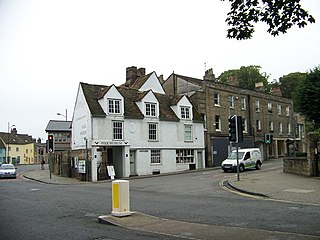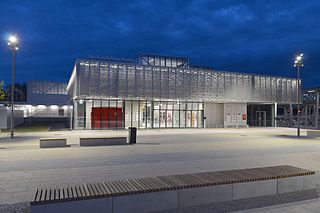
Cambridgeshire is a ceremonial county in the East of England and East Anglia. It is bordered by Lincolnshire to the north, Norfolk to the north-east, Suffolk to the east, Essex and Hertfordshire to the south, Northamptonshire to the west, and Bedfordshire to the south-west. The largest settlement is the city of Peterborough, and the city of Cambridge is the county town.

The Evoluon is a UFO-shaped building located in Eindhoven, the Netherlands. It was built in 1966 as a science museum by the electronics and electrical company Philips. It quickly became a landmark in Eindhoven, where Philips was headquartered at the time. The museum closed in 1989 and the building became a conference centre and exhibition venue in 1998. In 2022 it reopened for the general public again as the Next Nature Museum.

Cambridge is a city and non-metropolitan district in the county of Cambridgeshire, England. It is the county town of Cambridgeshire and is located on the River Cam, 55 miles (89 km) north of London. As of the 2021 United Kingdom census, the population of the City of Cambridge was 145,700; the population of the wider built-up area was 181,137. Cambridge became an important trading centre during the Roman and Viking ages, and there is archaeological evidence of settlement in the area as early as the Bronze Age. The first town charters were granted in the 12th century, although modern city status was not officially conferred until 1951.

East Cambridgeshire is a local government district in Cambridgeshire, England. Its council is based in the city of Ely. The district also contains the towns of Littleport and Soham and surrounding rural areas, including parts of the Fens.

Addenbrooke's Hospital is a large teaching hospital and research centre in Cambridge, England, with strong affiliations to the University of Cambridge. Addenbrooke's Hospital is located on the Cambridge Biomedical Campus. It is run by Cambridge University Hospitals NHS Foundation Trust and is a designated academic health science centre. It is also the East of England's major trauma centre and was the first such centre to be operational in the United Kingdom.

The Ontario Science Centre is a science museum organization based in Toronto, Ontario, Canada. Its original location was permanently closed to the public on June 21, 2024 and was located near the Don Valley Parkway about 11 kilometres (6.8 mi) northeast of downtown on Don Mills Road in the former city of North York. It was built down the side of a wooded ravine formed by one branch of the Don River located in Flemingdon Park.

The Museum of Science (MoS) is a nature and science museum and indoor zoological establishment located in Science Park, a plot of land in Boston and Cambridge, Massachusetts, spanning the Charles River. Along with over 700 interactive exhibits, the museum features a number of live and interactive presentations throughout the building each day, along with scheduled film showings at the Charles Hayden Planetarium and the Mugar Omni Theater.

Waterbeach is a village 6 miles (9.7 km) north of Cambridge on the edge of The Fens, in the South Cambridgeshire district of Cambridgeshire, England. It was designated a "new town" in 2018.

The A1309 is a short road which links the two ends of the A10 to north and south of Cambridge city centre in Cambridgeshire, England. It was numbered as part of the A10 prior to the construction of the Cambridge Western Bypass and the Northern Bypass.

COSI, officially the Center of Science and Industry, is a science museum and research center in Columbus, Ohio. COSI was opened to the public on 29 March 1964 and remained there for 35 years. In 1999, COSI was moved to a 30000 m2 facility, designed by Japanese architect Arata Isozaki along a bend in the Scioto River in the Franklinton neighborhood. COSI features more than 300 interactive exhibits throughout themed exhibition areas.

The New Museums Site is a major site of the University of Cambridge, located on Pembroke Street and Free School Lane, sandwiched between Corpus Christi College, Pembroke College and Lion Yard. Its postcode is CB2 3QH. The smaller and older of two university city-centre science sites, the New Museums Site houses many of the university's science departments and lecture theatres, as well as two museums.

The Museum of Cambridge, formerly known as the Cambridge & County Folk Museum, is a museum located in Castle Street in central Cambridge, England.

Primavera is a fine arts and crafts gallery at 10 King's Parade in Cambridge, England. Henry Rothschild founded Primavera in 1945 in Sloane Street, London, in order to promote and retail contemporary British art and craft. The Cambridge branch of Primavera was opened in 1959.

Cambridge North railway station is a railway station located in northern Cambridge, immediately adjacent to the suburb of Chesterton, close to Cambridge Science Park. The station is on the Fen Line, which runs from Cambridge to King's Lynn. It connects to the Cambridgeshire Guided Busway, and provides an interchange with Park & Ride and local bus services.

Copernicus Science Centre is a science museum standing on the bank of the Vistula River in Warsaw, Poland. It contains over 450 interactive exhibits that enable visitors to single-handedly carry out experiments and discover the laws of science for themselves. The centre is the largest institution of its type in Poland and one of the most advanced in Europe. In 2018, since its opening, it has been visited by over 8 million people.

The Centre for Computing History is a museum in Cambridge, England, established to create a permanent public exhibition telling the story of the Information Age.

Madingley Road is a major arterial road linking central Cambridge, England with Junction 13 of the M11 motorway. It passes by West Cambridge, a major new site where some University of Cambridge departments are being relocated.

Peterborough City Hospital is an acute teaching hospital on the Edith Cavell Healthcare Campus serving the city of Peterborough, north Cambridgeshire, areas of east Northamptonshire, areas of south Lincolnshire and Rutland. It is managed by North West Anglia NHS Foundation Trust.

The following is a timeline of the history of the city of Cambridge, England.

The North West Cambridge Development is a University of Cambridge site to the north west of Cambridge city centre in England. The development is meant to alleviate overcrowding and rising land prices in Cambridge. The first phase resulted from a £350 million investment by the university. The development opened to the public for the Open Cambridge event on 9 September 2017.






















